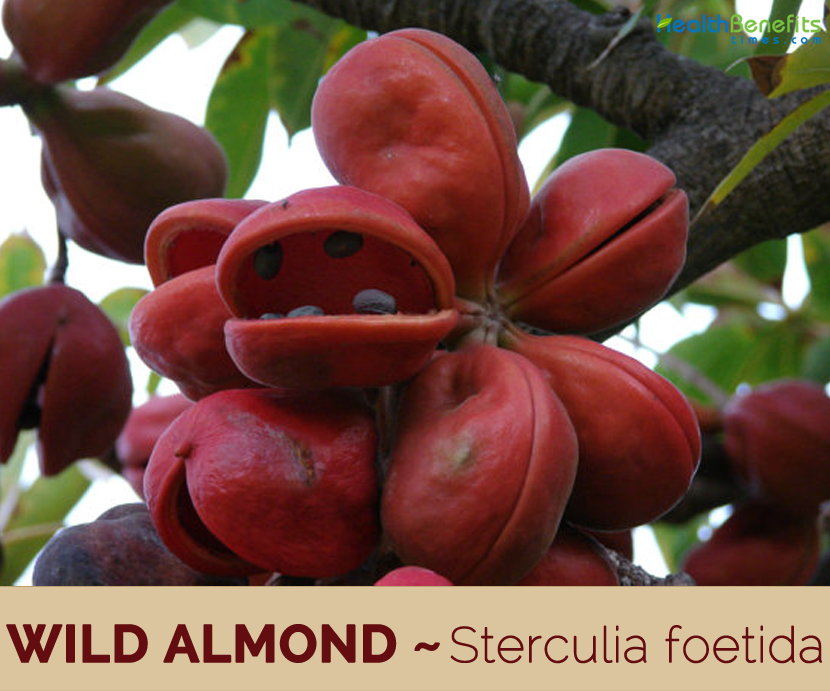| Wild almond Quick Facts | |
|---|---|
| Name: | Wild almond |
| Scientific Name: | Sterculia foetida |
| Origin | East Africa to north Queensland, Australia |
| Colors | Green when young turning to reddish when ripe |
| Shapes | Large, smooth, ovoid red nearly smooth, obovoid about 10 centimeters long follicle |
| Health benefits | Treat eczema, fever, broken limbs and dislocated joints, treat suppuratives cutaneous, skin eruptions, itching and skin diseases |
Plant Description
Wild Almond is an attractive, umbrella-shaped, spreading deciduous tree that grows about 35 meters (115 ft.) tall and 150 cm girth. The plant is found growing in primary and secondary forests, usually on river banks and sandstone rocks along the coasts, and in thickets and open areas. Although adaptable to most soils, it requires adequate moisture for optimum growth and development. The grey bark is smooth, spotted with brown and faintly ridged. The branches are whorled and usually horizontal, the numerous branchlets gracefully up-curved and crowded at the ends with large, palm-like leaves, remind one somewhat of the English Horse-chestnut.
Leaves
The leaves are placed at the end of branchlets; they have 125–230 mm long petioles; the blades are palmately compound, containing 7-9 leaflets. The leaflets are elliptical, 100–170 mm long, and shortly petioluled. The petioles are the source of the foul smell of the plant
Flower & Fruit
The flowers are arranged in panicles, 100–150 mm long. The green or purple flowers are large and unisexual as the tree is dioecious (male and female flowers are found on different trees). The calyx is dull orange and is divided into five sepals, each one 10-13 mm long. The fruit consists of four to five follicles; each follicle is large, smooth, ovoid red nearly smooth, obovoid about 10 centimeters long generally containing 10-15 seeds. The follicles are scarlet when ripe. Flowers appear in March, and the leaves appear between March and April. The fruit is ripe in February. Seeds are 2.5–3 cm long, purple black, velvety, ellipsoid or oblongish, with small waxy yellow rudimentary aril at one end. The seeds are edible after toasting and taste like chestnuts (Castanea sativa). They also contain oil that is used medicinally, while the timber is used for making furniture and the bark for rope.
Traditional uses and benefits of Wild Almond
- To treat eczema make a paste of wild Indian leaves by grinding them and apply over the affected areas.
- Bark decoction is used as abortifacient Indonesia.
- Roasted fruit skin or its ashes used as a decoction for gonorrhea in Java and leaf infusion used as aperients for fever.
- Leaves are used for washing head, root infusion used for bathing sick child or patient with jaundice in Java.
- Pounded leaves applied on broken limbs and dislocated joints.
- Heated oiled leaves are applied on abdomen of children to treat fever followed by placement of used leaves on the chest.
- Leaf decoction is used to treat suppuratives cutaneous eruptions in Philippines.
- Decoction of the bark is used in cases of dropsy and rheumatism as an aperient, diaphoretic, and diuretic.
- Decoction of the fruit is astringent.
- Bark and leaves are regarded as aperient, diuretic and diaphoretic in India.
- Decoction of the fruit is mucilaginous and astringent.
- Seed oil is used internally in itches and other skin diseases and is applied externally as a paste.
- Seeds are used as a purgative in Ghana.
- Oil from the seed is extracted on a local scale to be used in medicine.
- Decoction of the bark is used for dropsy and rheumatism as aperients, diaphoretic and diuretic in Philippines.
- Decoctions of leaves are used for skin eruptions.
- Decoctions of leaves are used for difficult labor.
- Paste of oil is applied to pruritic conditions.
- Oil from seeds given internally for itching and skin diseases, also applied externally as a paste.
- Decoction of fruit is used for blennorrhagia in Java.
Other uses:
- Wood: Wood is soft to very soft, light to very light with poor durability and is used for small project constructions like boxes.
- Fiber: Cord is made from bark fiber.
- Gum/Resin: Gum from trunk and branches, resembling gum tragacanth are used for book binding.
- Oil: Oil from Kernels is used as an illuminant.
- Paint: Oil mixed with white earth is used as paint.
Culinary Uses
- Seeds are roasted and eaten like chestnuts particularly in time of scarcity.
- Oil from the seed has also been used as culinary oil.
- Kernels have been used to adulterate cacao.
- Rootstock of young plants can be eaten raw and is a rich source of starch, with a flavor similar to jicama.
Other Facts
- Timber tree used for plank production, boxes, doors of huts, furniture, canoes, boats, guitars and toys.
- It is also planted as avenue trees.
- Seed oil is used as illuminant in Indonesia.
- Fiber is the inner bark of the tree and, when freshly stripped, has a lace-like character which adapts it for fancy work. It is used for making mats, bags, cordage, and paper.
- Gum that resembles ‘gum tragacanth’ is obtained from the trunk and branches and is used for book binding and similar purposes.
- foetida leaves contain up to 2.66% calcium and are also a good source of protein and phosphorus, meeting nutritional requirements of ruminants.
- Oil of Sterculia foetida has been found to be comparable to sunflower, soybean, and rapeseed oils for the use of biofuels.
References:
https://www.itis.gov/servlet/SingleRpt/SingleRpt?search_topic=TSN&search_value=506110#null
https://davesgarden.com/guides/pf/go/166443/
https://npgsweb.ars-grin.gov/gringlobal/taxonomydetail.aspx?id=101996
https://www.cabi.org/isc/datasheet/51446
https://plants.usda.gov/core/profile?symbol=STFO2
http://www.theplantlist.org/tpl/record/kew-2579743
https://en.wikipedia.org/wiki/Sterculia_foetida
Comments
comments
